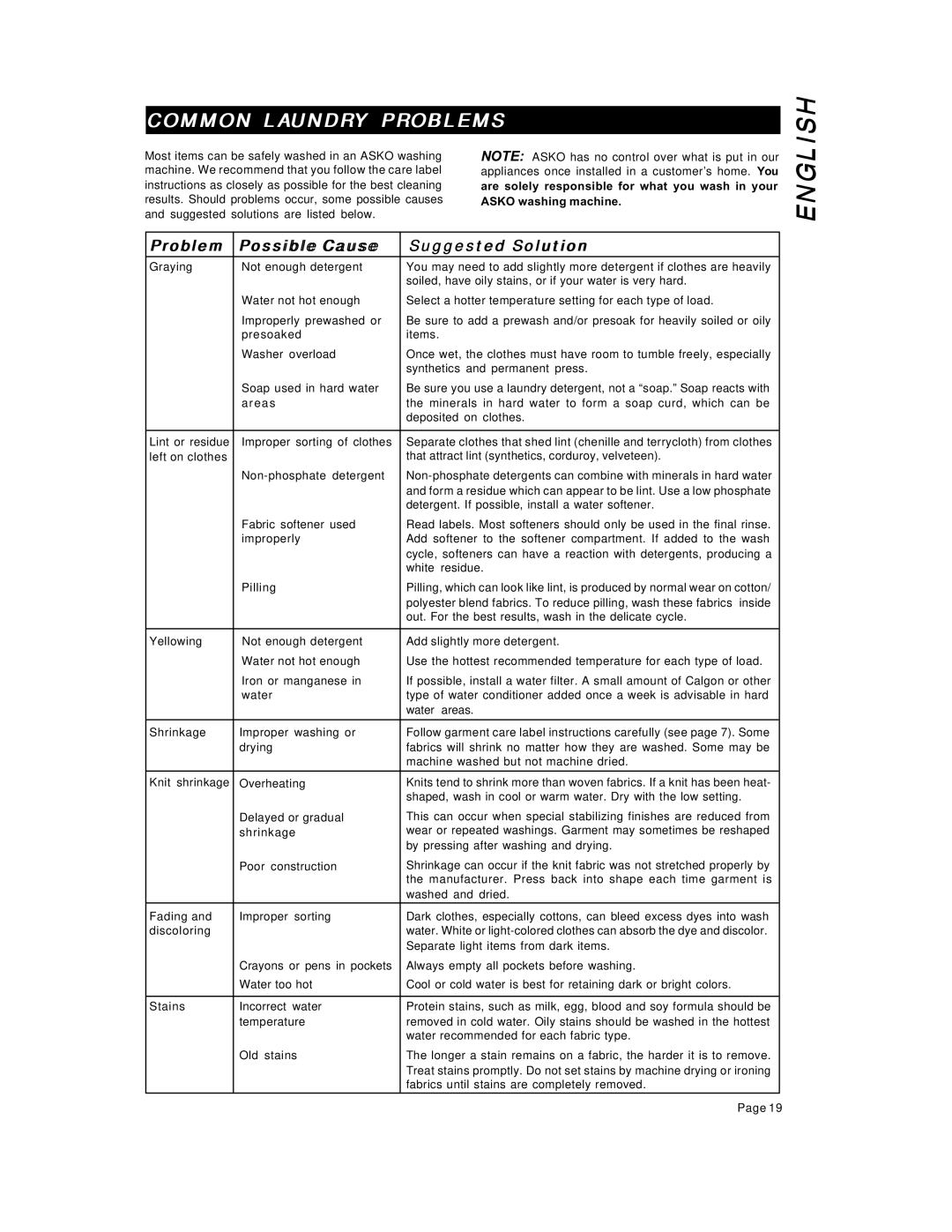COMMON LAUNDRY PROBLEMS
Most items can be safely washed in an ASKO washing | NOTE: ASKO has no control over what is put in our |
machine. We recommend that you follow the care label | appliances once installed in a customer’s home. You |
instructions as closely as possible for the best cleaning | are solely responsible for what you wash in your |
results. Should problems occur, some possible causes | ASKO washing machine. |
and suggested solutions are listed below. |
|
ENGLISH
Problem | Possible Cause | Suggested Solution |
|
Graying | Not enough detergent | You may need to add slightly more detergent if clothes are heavily |
|
|
| soiled, have oily stains, or if your water is very hard. |
|
| Water not hot enough | Select a hotter temperature setting for each type of load. |
|
| Improperly prewashed or | Be sure to add a prewash and/or presoak for heavily soiled or oily |
|
| presoaked | items. |
|
| Washer overload | Once wet, the clothes must have room to tumble freely, especially |
|
|
| synthetics and permanent press. |
|
| Soap used in hard water | Be sure you use a laundry detergent, not a “soap.” Soap reacts with |
|
| areas | the minerals in hard water to form a soap curd, which can be |
|
|
| deposited on clothes. |
|
|
|
|
|
Lint or residue | Improper sorting of clothes | Separate clothes that shed lint (chenille and terrycloth) from clothes |
|
left on clothes |
| that attract lint (synthetics, corduroy, velveteen). |
|
|
| ||
|
| and form a residue which can appear to be lint. Use a low phosphate |
|
|
| detergent. If possible, install a water softener. |
|
| Fabric softener used | Read labels. Most softeners should only be used in the final rinse. |
|
| improperly | Add softener to the softener compartment. If added to the wash |
|
|
| cycle, softeners can have a reaction with detergents, producing a |
|
|
| white residue. |
|
| Pilling | Pilling, which can look like lint, is produced by normal wear on cotton/ |
|
|
| polyester blend fabrics. To reduce pilling, wash these fabrics inside |
|
|
| out. For the best results, wash in the delicate cycle. |
|
|
|
|
|
Yellowing | Not enough detergent | Add slightly more detergent. |
|
| Water not hot enough | Use the hottest recommended temperature for each type of load. |
|
| Iron or manganese in | If possible, install a water filter. A small amount of Calgon or other |
|
| water | type of water conditioner added once a week is advisable in hard |
|
|
| water areas. |
|
Shrinkage | Improper washing or | Follow garment care label instructions carefully (see page 7). Some |
|
| drying | fabrics will shrink no matter how they are washed. Some may be |
|
|
| machine washed but not machine dried. |
|
Knit shrinkage | Overheating | Knits tend to shrink more than woven fabrics. If a knit has been heat- |
|
|
| shaped, wash in cool or warm water. Dry with the low setting. |
|
| Delayed or gradual | This can occur when special stabilizing finishes are reduced from |
|
| shrinkage | wear or repeated washings. Garment may sometimes be reshaped |
|
|
| by pressing after washing and drying. |
|
| Poor construction | Shrinkage can occur if the knit fabric was not stretched properly by |
|
|
| the manufacturer. Press back into shape each time garment is |
|
|
| washed and dried. |
|
Fading and | Improper sorting | Dark clothes, especially cottons, can bleed excess dyes into wash |
|
discoloring |
| water. White or |
|
|
| Separate light items from dark items. |
|
| Crayons or pens in pockets | Always empty all pockets before washing. |
|
| Water too hot | Cool or cold water is best for retaining dark or bright colors. |
|
|
|
|
|
Stains | Incorrect water | Protein stains, such as milk, egg, blood and soy formula should be |
|
| temperature | removed in cold water. Oily stains should be washed in the hottest |
|
|
| water recommended for each fabric type. |
|
| Old stains | The longer a stain remains on a fabric, the harder it is to remove. |
|
|
| Treat stains promptly. Do not set stains by machine drying or ironing |
|
|
| fabrics until stains are completely removed. |
|
|
| Page 19 | |
